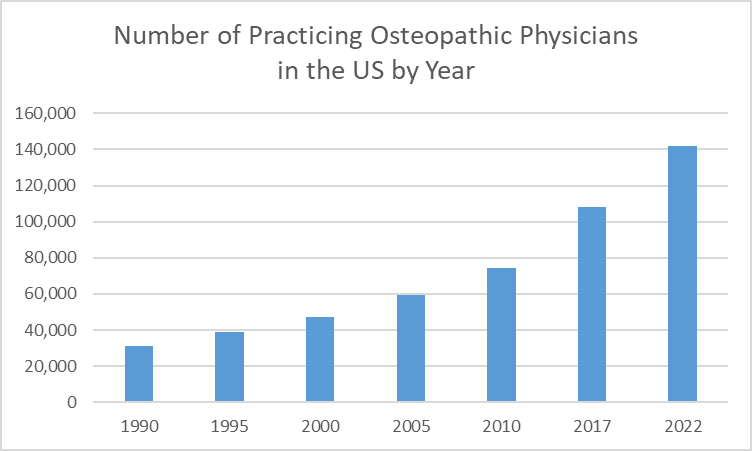 In a previous blog post, we outlined a number of trends in MD (allopathic) program admissions and matriculation in recent years. In summary, both application and enrollment numbers have reached record highs, while the percentage of applicants admitted has remained relatively constant over the past decade. For the first time ever, more women are applying to and attending MD programs than men, and classes have become more racially, ethnically, and socioeconomically diverse.
In a previous blog post, we outlined a number of trends in MD (allopathic) program admissions and matriculation in recent years. In summary, both application and enrollment numbers have reached record highs, while the percentage of applicants admitted has remained relatively constant over the past decade. For the first time ever, more women are applying to and attending MD programs than men, and classes have become more racially, ethnically, and socioeconomically diverse.
In this companion post, we turn our attention to DO (osteopathic) programs. How have application and enrollment numbers changed in recent years? Has the composition of classes shifted, and along which demographic axes? And how do the changes in DO programs compare to those in MD programs?
Broad Application and Admissions Trends
As with MD programs, the number of applications to DO programs has soared in recent years. Between 1977-78 and 2019-20, the number of applicants increased over five-fold, from under 4,000 to over 21,500; in the decade from 2008-2009 through 2018-2019, the applicant pool grew by 79%. Enrollment has shot up correspondingly: according to the latest OMP Report from the American Osteopathic Association (AOA), the number of students enrolled in osteopathic medical schools has grown by 77% over the past decade.
These rates of increase are much greater than those experienced by MD programs: allopathic enrollment has grown about 18% in the past decade (a much smaller figure than DO’s 77%). But that makes sense, given that there are comparatively far fewer students overall enrolled in DO programs: 36,500 to MD programs’ 96,520. (The smaller the field, the fewer additional students it takes to create a big percentage increase.) The relative sizes of MD and DO enrollment, in turn, make sense because osteopathy is a much younger field. While MD programs have existed in the US in some form for over two and a half centuries, the osteopathic profession has been around for about half that time.
But, bottom line: DO programs are growing, and along with them the size of the field more broadly. Over the past decade, the total number of osteopathic medical students in the U.S. plus practicing DOs has increased by 81%. The graph below, from the 2022 OMP Report, gives a visual representation of the growth in the number of DOs practicing in the US over the past three decades:
DOs’ share of the medical profession continues to grow, too. Osteopathic doctors currently comprise more than 11% of the U.S. physician population, but more than a quarter of all current U.S. medical students are in DO programs, so that share of the pie is set to keep growing.
Trends by Demographic Factors and Medical Specialties
Age. According to the AOA, DO doctors are getting younger. The proportion of practicing DOs under 45 years old has grown by 16% over the last ten years; in total, over two thirds of DOs in the US currently fall into that youthful age bracket.
Gender. As with MD programs, DO programs are becoming increasingly female. While 43% of practicing DOs are female and 47% of practicing DOs under 45 are female, more than half of first-year DO students in 2021-22—54%, to be exact—were women, indicating that the overall percentage of women in the field will continue to increase. See the below graphic from the AOA:
Specialty Fields. Osteopathic medicine “has a proud history of educating and training primary care physicians,” as the AOA puts it. This is because the philosophy of osteopathic medicine prioritizes preventative care and a holistic approach to treating each individual. At present, 57% of DOs practice in primary care fields. Over the years, there has been a slight uptick in the percentage of DOs in specific primary care subspecialties. While the percentage of DOs in Family Medicine/General Practice has held constant at 16.4% between 2007 and 2021, the percentage in Internal Medicine has increased from 4.6% to 5.8%, in Internal Medicine/Pediatrics, from 4.5% to 5.4%; and in Pediatrics, from 3.3% to 4.8%.
Outside of primary care, DOs’ top five specialties are Emergency Medicine, Anesthesiology, Obstetrics & Gynecology, General Surgery, and Psychiatry. Via the AOA:
Source: Osteopathic Medical Profession Report, 2022
For guidance on navigating the complexities of the medical school application process—whether you are planning to apply to MD-granting (allopathic) medical schools, DO-granting (osteopathic) medical schools, or a combination—feel free to contact us. As always, at Collegiate Gateway, we’re happy to help!



